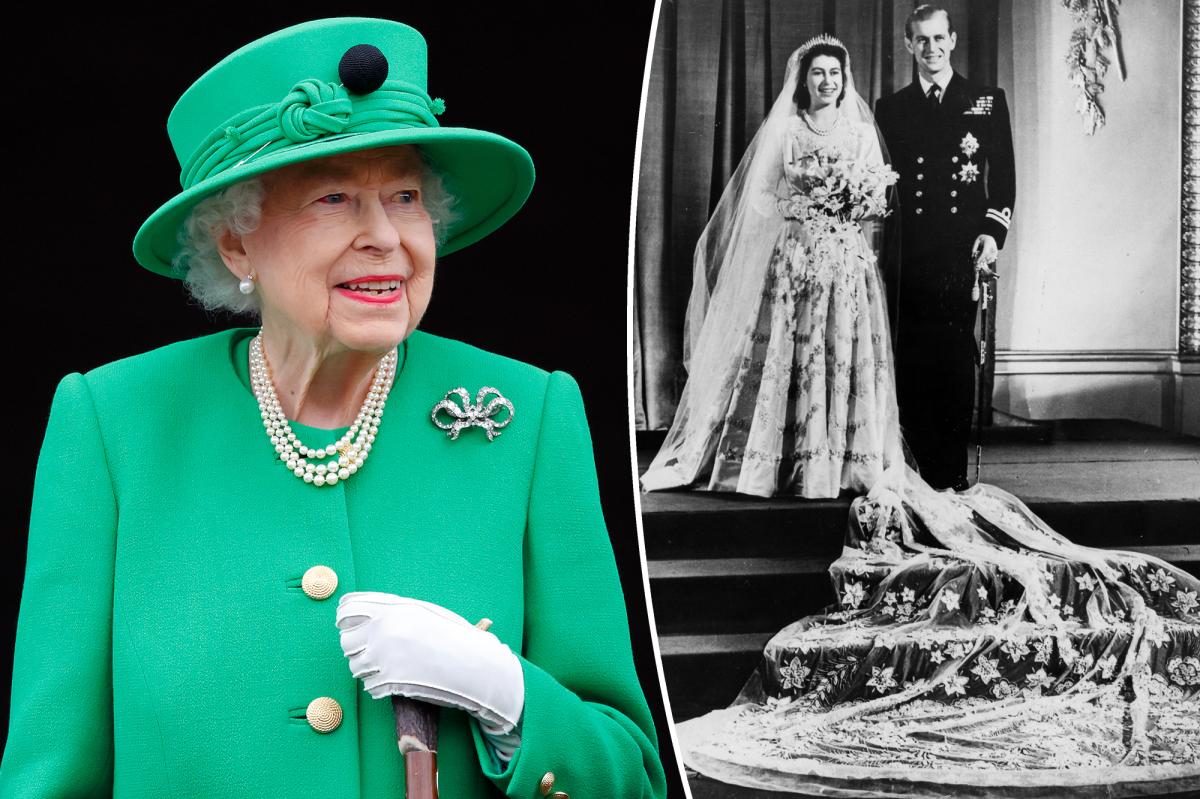Queen Elizabeth II, the longest-reigning monarch in British history, died on September 8, 2022 at her home in Balmoral. She was 96 years old.
The ever-stylish royal married dashing naval officer Prince Philip of Greece on November 20, 1947, in the wedding everyone had been waiting for in post-World War II Britain.
Leading up to the big day, speculation about what the 21-year-old princess would be wearing down the aisle ran feverishly; the windows of designer Norman Hartnell’s studio had to be covered to prevent espionage, and there’s even a historical novel about the making of the famous dress, entitled “The Gown.”
The beautiful garment has a remarkable story and we look back at the wedding of Princess Elizabeth and Prince Philip with five fascinating facts about her beautiful dress.
1. The final design is approved less than three months before the wedding.
While many brides today order their dresses nine months to a year or more in advance, Princess Elizabeth’s dress wasn’t started until August 1947, according to the Royal Collection Trust — less than three months before her wedding.
A design sketched by Norman Hartnell, one of the foremost fashion designers in England at the time, won; he called it “the prettiest dress I’ve made yet,” according to People.
It took the hard work of 350 women to create the intricately detailed piece in such a short time, and they were all sworn to secrecy to prevent details about Princess Elizabeth’s special day from leaking to the press.
Betty Foster, an 18-year-old seamstress who worked on the dress at Hartnell’s studio, told the Telegraph that “Americans rented the flat across the street to see if they could catch a glimpse of the dress, and that [Hartnell] had to cover the windows of the study with whitewash and muslin to deter snoops.”
2. Ordinary women gave Princess Elizabeth their ration coupons to help pay for the dress.
In post-war Britain, austerity measures meant people had to use clothing coupon coupons – and as you can imagine, a designer wedding dress wasn’t exactly within that budget.
The expensive fabric used for Princess Elizabeth’s dress was particularly hard to come by at the time, as bridesmaid (and Prince Philip’s cousin) Lady Pamela Hicks told People.
“Tule could be bought easily, while Duchess satin was so hard to come by at the time,” she said, adding that the bridesmaids wore tulle dresses while the princess dress was made of satin with tulle accents.
The British government gave Princess Elizabeth 200 extra ration coupons, per city and country, but women in the UK were so happy to see her get married that they even sent her their own vouchers to cover the dress.
While Hicks told the princess to email them back — it was actually illegal to give away coupons — it was a moving show of support for Elizabeth and the monarchy.
“It showed how people wanted to be involved,” said the royal bridesmaid.
3. The princess’ dress is inspired by a painting by Botticelli.
According to the Royal Collection Trust, Hartnell’s inspiration for the wedding dress came from an unusual place: the painting “Primavera” by the famous Italian artist Sandro Botticelli.
The word “primavera” means spring in Italian, and the painting depicts Flora, the goddess of spring, and Venus, the goddess of love and beauty – a perfect way to combine the new beginnings of a wedding and also a fresh start. after the war .
Like the flower-adorned dress in the painting, Princess Elizabeth’s was covered in intricate flower and leaf motifs embroidered with crystal and pearl.
The Royal Collection Trust describes on its website how Hartnell said “the motifs had to be put together in a design that was in proportion like a florist’s bouquet.”
4. The design featured 10,000 seed pearls imported from America.
A detail that stands out on Princess Elizabeth’s wedding gown and elaborate veil? Her look is covered in an amazing 10,000 seed pearls, all sewn onto the dress by hand in a floral pattern.
While care was taken to produce the silk and satin in Britain (including Lullingstone Castle, Kent and Dunfermline, Scotland, according to the Royal Collection Trust), the pearls of the dress were actually imported from America.
A problem with the silk fabric? The palace was supposed to reassure the public that the silkworms came from China, and not from one of the countries Britain fought in the war, such as Japan or Italy, according to Town and Country.
5. Princess Elizabeth didn’t change the dress until her wedding day.
While members of the royal family clearly have wedding dress fittings like other brides-to-be, it turns out that Princess Elizabeth doesn’t actually know if her dress fit properly until the morning she got married.
Foster, the seamstress mentioned earlier, told the Telegraph that Elizabeth’s dress was delivered on the wedding day, “respecting the tradition that it would be bad luck” to try it on ahead of time.
While another staff member, Miss Yvonne, went to Buckingham Palace to fit the bride, Foster revealed that some wedding day jitters were involved.
“She told us that the King had offered Princess Elizabeth a drink to calm her nerves, but she declined.”

